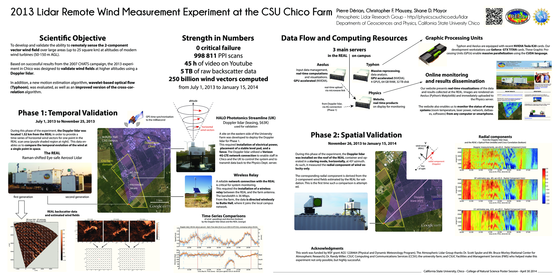HD movie (mp4, 30 MB) can be downloaded here.
Work in Progress
Chico 2013 Experiment
The Chico 2013 Experiment involved the real-time estimation of 2D, 2-component motion fields from aerosol backscatter data. Chris Mauzey and I designed and implemented the numerical framework that made this experiment possible. It involved the retrieval and organization of raw backscatter data; the motion estimation; as well as visualization of products (e.g. vector fields) in real-time, 24/7 over more than 6 months. Our solution combines Python, C++/CUDA, MySQL and HTML+PHP. Over the course of the experiment, more than 5 TB of raw data were collected and 250 billion wind vectors estimated. The poster below (click for full size) describes some aspects of the experiment.
Typhoon software
A significant part of my work consisted in preparing Typhoon 2.0 with the precious help of Chris Mauzey:
- To accept rectangular images, whereas previous version required square images of dimension a power of 2.
- To rewrite the so-called continuous regularization schemes as convolutions instead of matrix products (to avoid to store huge matrices), thus enabling to process arbitrary large images.
- To add a pyramidal scheme, so as to handle very large displacements.
- Finally, to rewrite everything in CUDA, to benefit from the huge speed gain brought by GPU parallel computing
The Typhoon code is currently running since June 2013, providing real-time wind fields from backscatter imagery taken by the REAL. Some recent results can be visualized through the web-application, more options are available in the links section.
The software and its source code are registred by the French Agency for the Protection of Programs (APP), which enables licensing. Feel free to contact me for further information.
Typhoon Demos
Aerosol Backscatter
Please visit the Typhoon page, and/or the Lagrangian visualization page.Water Vapor
[Nb: watch video in 720p] This is a demo using satellite imagery. Input frames are water vapor images taken by GOES satellite over the U.S. East coast, during Nemo winter storm (8 Feb. 2013) - source CIMSS Satellite Blog.
Ink on milk
The video below features ink drops on the surface of milk. When dishwashing liquid is added, ink drops are dispersed due to suface tension modification, resulting in a visible motion. This apparent motion is extracted by Typhoon algorithm, and later visualized through particle trajectories.
Background
After graduating from highschool in 2004, I studied for five years in Toulouse, France, at the Institut National des Sciences Appliquées (INSA), where I obtained in 2009 a Master of Engineering degree specialized in Mathematics and Modelling. I received the same year a Master of Science in Applied Mathematics from the Institut de Mathématiques de Toulouse (IMT).
I worked as a PhD student at Inria Rennes - Bretagne Atlantique, in Rennes, France, from October 2009 to November 2012, within the Fluminance team under the supervision of Patrick Héas and Etienne Mémin. I developed a wavelet-based optic flow algorithm (Typhoon), to extract the apparent motion from image sequences. This estimator is mainly dedicated to turbulent fluid configurations. More information is available on my Fluminance webpage, in particular several examples of fluid motion visualization and estimation. The full dissertation "Wavelets & Fluid Motion Estimation" can be downloaded here (PDF in English, ~15 MB), the abstract is presented below.
The objective is to propose a novel "optical flow" algorithm dedicated to the multiscale motion estimation of fluid flows, using a wavelet representation of the unknown motion field. This wavelet formulation introduces a multiscale framework, conveniently adapted both to the optical flow estimation and to the representation of turbulent motion fields. It enables as well to design divergence-free bases, thereby respecting a constraint given by fluid dynamics. Several regularization schemes are proposed; the simplest consists in truncating the basis at fine scales, while the most complex builds high-order schemes from the connection coefficients of the wavelet basis. Proposed methods are evaluated on synthetic images in the first place, then on actual experimental images of characteristic fluid flows. Results are compared to those given by the usual "cross-correlations", highlighting the advantages and limits of the wavelet-based estimator.
Selected Publications
Dérian, P., C. F. Mauzey, and S. D. Mayor, 2014:
Wavelet optical flow for 2-component wind fields from aerosol backscatter lidar data,
poster #25,
American Meteorological Society 21st Symposium on Boundary Layers and Turbulence (AMS BLT), 9-13 June 2014, Leeds, UK.
Dérian, P., C. F. Mauzey and S. D. Mayor, 2013: Wavelet optical flow for 2-component wind field from horizontally scanning lidar data,
Weather-Driven Renewable Energy Posters #A13G-0303,
American Geophysical Union (AGU) Fall Meeting 2013, San Francisco, CA.
Kadri Harouna, S., P. Dérian, P., Héas, and E. Mémin, 2013: Divergence-free Wavelets and High Order Regularization,
International Journal of Computer Vision, Vol. 103, pp. 80-99.
Dérian, P., P. Héas, C. Herzet and E. Mémin, 2013: Wavelets and Optical Flow Motion Estimation,
Numerical Mathematics: Theory, Methods and Applications, Vol. 6, pp. 116-137.
Dérian, P., 2012: Wavelets and Fluid Motion Estimation,
Ph.D. Dissertation, University of Rennes, France.
Dérian, P., P. Héas, E. Mémin and S. D. Mayor, 2010: Dense motion estimation from eye-safe aerosol lidar data,
p. 377-380 of Vol. 1 of Proceedings of the 25th ILRC. Oral presentation S3O-04 (Thurs. July 8).

